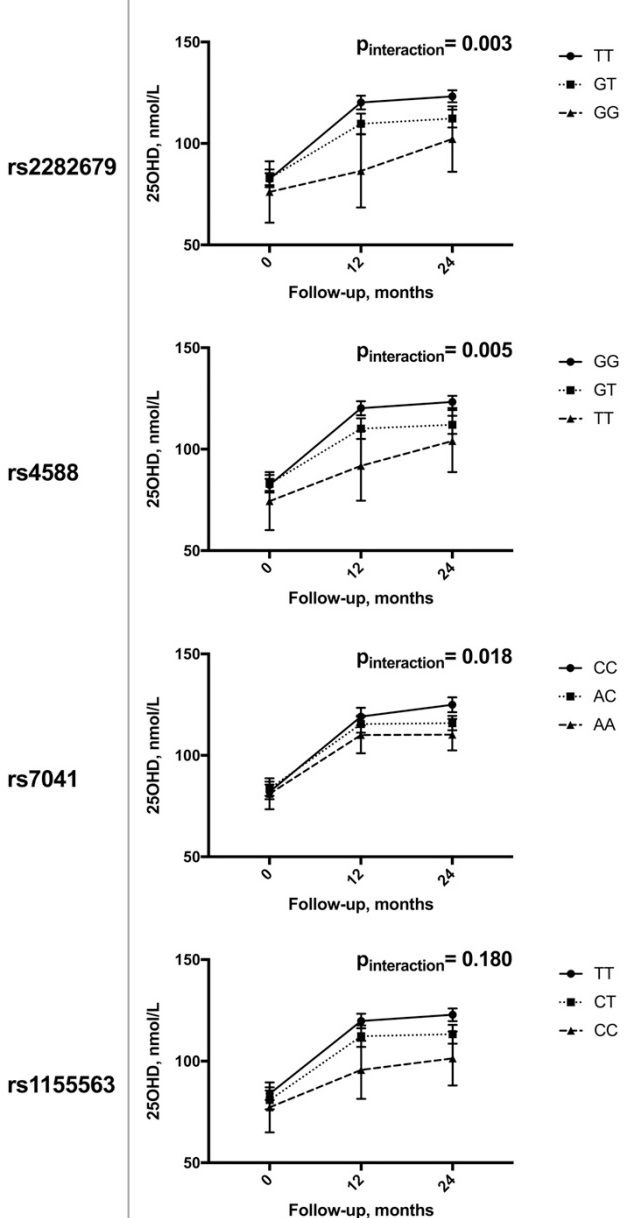Poor protein binding gene associated with poor Vitamin D response – RCT
Genetic Variation of the Vitamin D Binding Protein Affects Vitamin D Status and Response to Supplementation in Infants
J Clin Endocrinol Metab . 2019 Nov 1;104(11):5483-5498. doi: 10.1210/jc.2019-00630.
Maria Enlund-Cerullo 1 2 3, Laura Koljonen 2 3, Elisa Holmlund-Suila 1 3, Helena Hauta-Alus 1 3, Jenni Rosendahl 1 3, Saara Valkama 1 3, Otto Helve 1, Timo Hytinantti 1, Heli Viljakainen 2 4, Sture Andersson 1, Outi Mäkitie 1 2 3 5, Minna Pekkinen 1 2 3

📄 Download the PDF from VitaminDWiki
Context: Single nucleotide polymorphisms (SNPs) of the vitamin D binding protein encoding the GC (group component) gene affect 25-hydroxyvitamin D (25OHD) concentrations, but their influence on vitamin D status and response to vitamin D supplementation in infants is unknown.
Objective: To study GC genotype-related differences in 25OHD concentrations and the response to supplementation during a vitamin D intervention study in infants.
Design: In this randomized controlled trial, healthy term infants received vitamin D3 (10 or 30 μg/d) from 2 weeks to 24 months of age. GC SNPs rs2282679, rs4588, rs7041, and rs1155563 were genotyped. rs4588/7041 diplotype and haplotypes of rs2282679, rs4588, and rs7041 (Haplo3SNP) and of all four SNPs (Haplo4SNP) were determined.
Main outcome measures: 25OHD measured in cord blood at birth and at 12 and 24 months during intervention.
Results: A total of 913 infants were included. Minor allele homozygosity of all studied GC SNPs, their combined haplotypes, and rs4588/rs7041 diplotype 2/2 were associated with lower 25OHD concentrations at all time points in one or both intervention groups [analysis of covariance (ANCOVA) P < 0.043], with the exception of rs7041, which did not affect 25OHD at birth. In the high-dose supplementation group receiving 30 μg/d vitamin D3, but not in those receiving 10 µg/d, genotype of rs2282679, rs4588, and rs7041; diplotype; and Haplo3SNP significantly affected intervention response (repeated measurement ANCOVA Pinteraction < 0.019). Minor allele homozygotes had lower 25OHD concentrations and smaller increases in 25OHD throughout the intervention.
Conclusions: In infants, vitamin D binding protein genotype affects 25OHD concentration and efficiency of high-dose vitamin D3 supplementation.
Trial registration: ClinicalTrials.gov NCT01723852.
